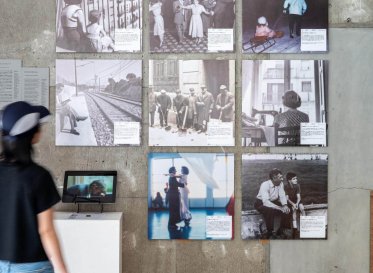
The world can be designed, if you could be imagined
When I wrote about the relationship between "Understanding" and "Creating" in the article last time, "How to attend the unknown" learned by collectors in the Renaissance period ", my colleagues wrote about the relationship between knowledge and imagination I'd like to receive a request.
When I think about it again, do you work day by day with your imagination working? It is very important.
Without imagination, you can not realize what you want to happen, and you can not control things not to happen.
That means that you can not do the direction. Wow, that's tough! Therefore, the theme of this time is "About relationship between knowledge and imagination."
It is important to feel "marvel"
Let’s start with the word “thaumazein”.
In Greek it means words “surprise” and “wonder”.
It is “a marvelous room” introduced in the last article , thought to be remembered (to remember) by saying “wonder”. It is “a museum with everything” that was popular in Europe from the 15th century to the 18th century.
I wrote “Anything” here means that the collection collected in the “marvelous room” is not clearly classified like the current museums and museums, and there was no collection criteria Do not mean.
Rather, “wonder room” had clear and rigorous collection criteria.
Whether it feels “marvel” or not?
Rarities that attract viewers with their mystery Whether it is yours or not?
That was the norm of value judgment in the place of intellectual exploration, from the 15th century to the 18th century, that is to say the museum of Linnae to be taxonomic.
"Wonder" is the beginning of intellectual exploration
What was linked to “marvel” and intellectual exploration is not only in the “wonder room” since the 15th century.
In the history of Europe, in the area of Greek philosophy already “wonder = tha muzein” was already said to be the beginning of intellectual exploration.
For example, Aristotle wrote in “metaphysics” that “it is surprising, initially, and what has come down to philosophy for human beings now”.
This surprising thing is that among those unexplained phenomena, the person who moves to the nearest one, the person who has advanced a little further goes to a more difficult question … although he can not explain anything, but he is surprised , I realize my ignorance.
When.
Humans are surprised to find events that can not explain what it is. And the surprise draws people’s interest. If you have an inquiring mind, follow that interest, head for elucidation of the mystery before you.
That is the beginning of philosophy, Aristotle says.
In other words, people do not explore something that does not draw their attention.
The object of wonder that attracts attention can be subject to intellectual exploration.
That is why the European knowledge layers since the 15th century were brought up by their intellectual curiosity and gathered rare items on the “marvelous room”. We collect the objects of “surprise” and “wonder”, put it in hand, observe and analyze, and advance intellectual quest. It can be said that it was a Renaissance appearance of the philosophical attitude that arises from Aristotle.
Did you see the relationship between knowledge and wonder somehow?
From now on I want to think about how it will lead to imagination.
As a guide to that story, I would like to continue talking while referring to three books as I did last time. This three volumes is this.
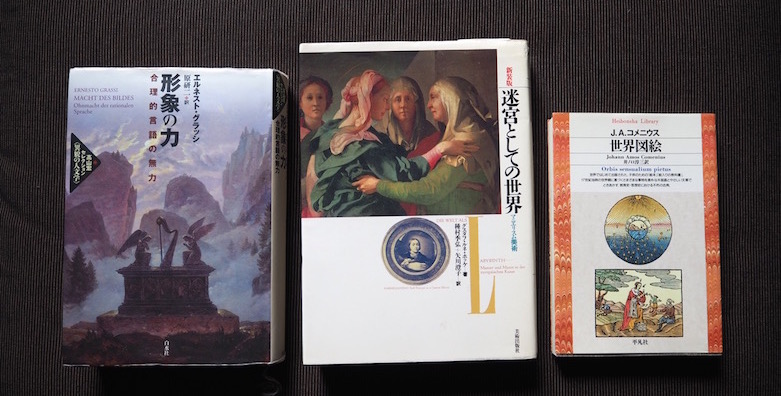
/ Comenius "World drawing"
To be surprised and to see
So that’s the first one. Ernesto Grassi is a book called “the power of figurines”, which picks up “surprise = thaumsein” in Greek philosophy represented by Aristotle.
Grassi refers to the relationship between “surprising” and “seeing” in etymological consideration of “Taumazein”.
<Tha muzein thaumazein> is a derivative word of <thirsty theasthai> when it means <look> <perceive> <observe>.
When. In the very “room of wonder”, it is thought that collecting objects subject to “wonder” were collected for the purpose of “looking” and “observing”.
In addition, Grassi explores the relationship between wonders and knowledge from Tha mass and Iris’ father and daughter in Greek mythology, drawing a sentence like Plato’s “Teatitos” as follows.
It is a state of a man who loves wisdom very much. Surprising. Besides this there is no principle of philosophy. Those who told Iris is the daughter of Thaumus seems to be saying good family line.
The name of Tha mass is said to mean “strange thing”. On the other hand, Iris is a characterization of the rainbow, it was said to be a role of transporting heavenly world and the earth world, gods and humans. It is a role to notify humans by visualizing the world of the gods like a rainbow.
In other words, the connection between Tha mass and Iris’s father and daughter showed a relationship between wonder and knowledge in the sense that it is expressed in the relationship between “funny” father and “girls’ world visualization” daughter It can be said that it is stuff.
Can you see it surprisingly?
Well, I would like to ask you again here.
Why are “surprises” and “watching” connected? When.
Here, I want to think about the existence of Iris again.
Iris is said to be a personification of a rainbow. Why should we question this as a role of transporting gods and humans? I’m saying that. For us, the rainbow is not a “role to transport the gods and humans”. The reason why the rainbow looks like it is because the ancient person had an eye to capture it as “wonder”.
In other words, how do you see? It is a problem of.
How do you see? By the same rainbow can be seen as “wonder” and it will become a daily life that tends to be overlooked.
How did you see if you could find a “wonder” that triggered intellectual exploration? It depends on viewpoint, what did you see? I also notice that it is not dependent on the object of.
Actually, even if you look around the usual.
What makes you surprised at what people, what motivates your curiosity, and what you want to pursue is different.
Even if I meet the same thing, there are people who can start to consider themselves properly with proper doubt, there are people who can not pass thought at all and can not think about anything. How do you see whether Aristotle can become a person who can start philosophy as intellectual exploration by thinking “ignoring my ignorance” and become a person who does not have any progress as a result of understanding? It is up to you.
Draw the image of the inside
When it becomes, it seems that it is important to watch “suddenly”.
Moreover, that “seeing” is more about how to have an image than to grasp what is in front of the eyes. It is close to “imagination”. In fact, even if the object of interest is in front of me, it is up to people to imagine what to find in it.
In that respect, Federico · Zuccari which was a painter of the 17th century and also an architect showed the concept “disegno interno” which is interesting.
In 1607, Zuccari theorized the creation of artists in the essay “paintings, sculptures, architectural ideas” through the idea of Diseño / Intelón. As German cultural historian Gustav René Hocke explains Duccinho Intelón of Zuccari in the “Labyrinth of the world”, we refer to it and explain why it is “knowledge and imagination I would like to explain whether it is interesting from the viewpoint of the viewpoint.
Hocke will write like this.
Zucchari says at first <a beautiful thing in our spirit> is born. In short, there are certain idea concepts, certain <internal composition = Dicheno Intelo>.
Beautiful birth born inside. I think that the beauty is a beautiful outdoor beautiful idea, and if you can easily think of it as a strange image that would not normally come up with. Zucchari thinks that it is the artist’s power to see such a strange image. And this commonly unexpected strange image is that it is Duchenho Internano of Zuccari.
Please confirm that this leads to the view that looks for “marvel” earlier = viewpoint. Artists’ power to see is “wonder”. And the image of “marvel” found in the artist is the image of Diseño · Intel.
Hockey keeps going further.
Thus we turn this into reality and succeed in combating <external composition = Diceno · estero>.
This is similar to the daughter of Tha Mas, the iris which is the characterization of the rainbow. If Tha mass is the inner composition imaginable in the minds of artists = decinho intelo, Iris is an external composition = artist depicting in the real world by artist.
History of painter's drawing
Well, interesting is from here.
Hocke points out the role of artist’s role in the Zuccari era, “God creates a thing of nature and artists create artificial things”
Thuccari is said to be a painter of the era of the post-era Mannerism period than the time when Leonardo da Vinci, Michelangelo, Raphael and others were said to be the three great masters of the Renaissance. Speaking of his masterpieces, Leonardo’s “Mona Lisa” was produced around 1503 – 1519, Raffaello’s “Athenian School” was 1509-1510, Michelangelo’s “Last Judgment” was 1537-1541, and the nearest Michelangelo But with Tuccarly there is a time gap of less than 70 years.
The gap of that era appears as a difference between a high-quality painter of Renaissance and a painter of Mannerism.
Whereas the painters of the High Renaissance aimed to imitate the faithfulness of nature using techniques such as perspective and the artists of the Mannerism tries to draw faithfully to the image envisioned on their inner face It became a difference.
In other words, it was the artists of the Mannerism who headed towards making human beings more creative, and that being the concept was the Zuccari’s Diseño Intelo.
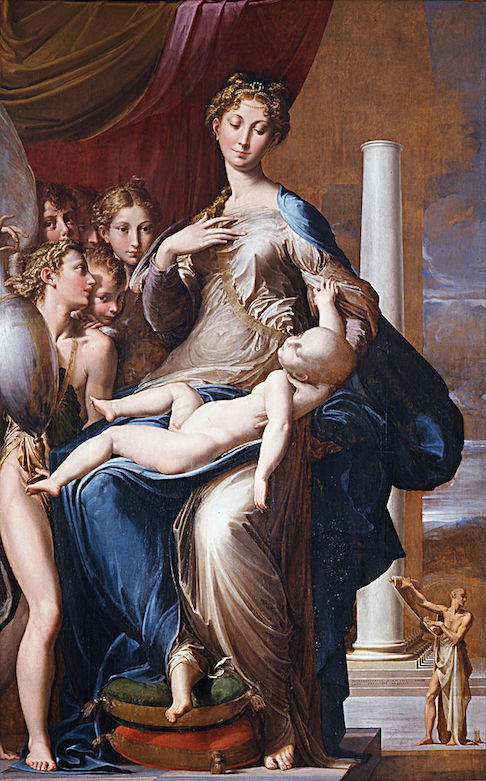
Furthermore, when organized, the painters of the High Renaissance themselves were shifting from a painter who depicts the world of God in the Middle Age era to a painter who paints real nature, so the change of what the painter draws is ” “~” Real world of nature “~” Artificial world that human beings imagined in the mind “. It was like this time that human beings started creation based on their own images in their heads.
Visual intelligence and design
There is an interesting signature.
According to the Oxford English dictionary, the word “design” as English first appeared in 1593. In addition, the usage of “picture” seems to be 1638 in the beginning. Zuccari’s “Idea of Painting, Sculpture, Architecture” is 1607 years.
And, Diseño · Intelón. It is interior design if you translate it in English. In this era, the keyword of design will come up at a stretch. Moreover, with the concept of externalizing the image of the inside.
It is said that it is around that time that human beings came to create artificial things based on images in their heads. It can also be said that it is an era when a method of human creation as design was born.
To be precise, there was a precursor a little before that.
Genius Leonardo et al. Designed machines such as helicopters, tanks, hydraulic powered mills and wheat and rice hulls separators, because they started to create artifacts. However, as is well known, many Leonardo’s inventions ended with ideas, and in fact many are not actually reality.

In this Leonardo example, it is beyond the fact that Dicenseo Internano is painted as a painting by the painter, but as the externalization of the imagination in a more designing sense = Diceno · Estello is done In order to become, it was necessary to have a technology for externalization different from drawing a picture.
Therefore, in order to be able to realize the design in the real world using internal imagination, its imagination also needed to be linked with the skill of craftsmen who creates things.
Knowledge of skill of craftsmen, and visual expression for that
What I would like to see here is “world drawing” which is said to be the world’s first pictorial textbook by Comenius known as a prominent educational scholar.
Comenius is a person who envisioned the same school curriculum in the same grade at the same time as a child of the same age which is adopted in many countries including Japan as well as studying the same curriculum in the same grade and graduating at the same time It is said. In the era when Comenius survived Europe was broken up in the struggle between Catholicism and the New Testament and it was also era. Under such circumstances, Komenius drew a dream that Europe will become one again by children learning the same curriculum using a textbook with a description written in various languages. In 1658 it was published that “World drawing” that had its dreams. It is about 50 years since the time of Zuccari.
To be pictures is the first point. It’s not just a picture book because it’s for children. As in the marvelous room, in this era, the knowledge was visualizing power anyway. It is because it was an era in which emphasis was placed on experimentalism and empiricism. It is an era when it was considered to be knowing. Here is the relationship between knowledge and imagination. Knowing is to reflect on the image.
And here is another reason why I introduced “world drawing”. Because the knowledge introduced by Comenius with painting includes various occupations.
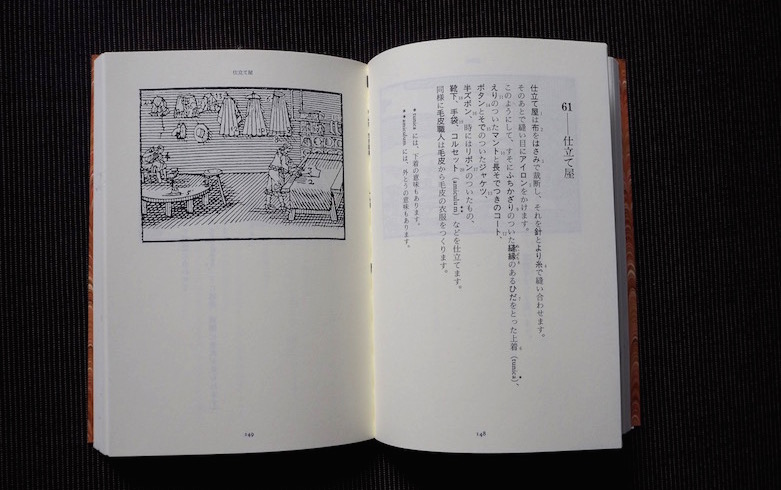
If you think about this simply as something like a kind like introducing the work of adults to children in contemporary society, you overlook important points. Comenius thought that knowledge on occupation was necessary for children’s education because it was thought that it was the knowledge necessary for newly reviving Europe. And understanding information on craftsmen as knowledge itself, in Europe was a paradigm shift of one knowledge.
Age when artisan skills became knowledge
In considering that, I would like to refer to an encyclopedia which is one of the prevalent in the field of publication, a little late.
In famous places, “encyclopedia” by EFrame Chambers in the United Kingdom was written in 1728, “Encyclopaedia” compiled mainly by French Enlightenment Thinkers Diderot and D’Alembert, from 1751 to 1772, Each has been published.
“World drawing” can be seen as an encyclopedia for children ahead of such encyclopedia compilation epidemic.
It is actually a craftsmanship technique to occupy much of the information handled in that encyclopedia.
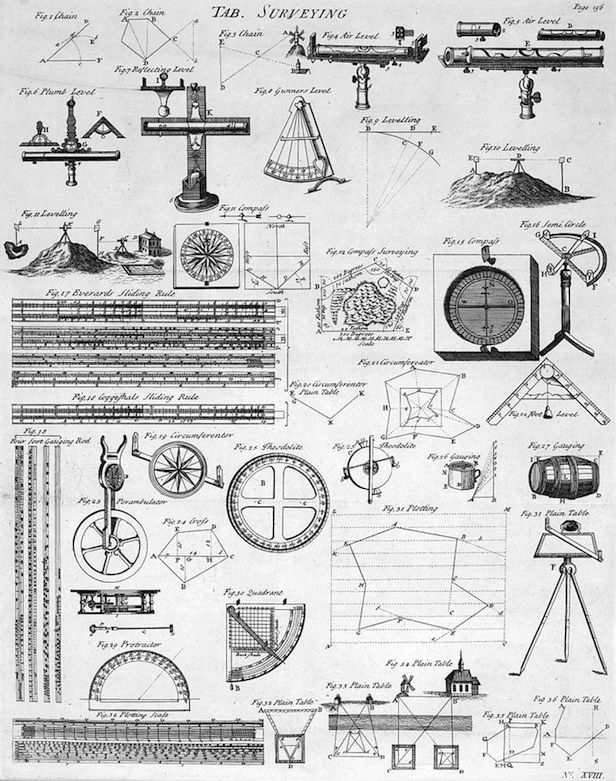
Actually, this broadened the paradigm of intellectual information in Europe. In the past Europe it had not taken up craftsmanship knowledge in the field of academics. Because basically it was to learn about God. In the Renaissance period, at the same time as the artist began depicting nature, for example in the field of medicine, knowledge of people with professionals such as craftsmen who do so-called surgical procedures and pharmacists dealing with drugs Academic medicine scholars also come to be introduced. That is why many of the people with amazing rooms are doctors and pharmacists.
It is interesting that Daniel Defoe’s “Robinson Driftwriter”, which was published in 1719 before nine years ago when Chambers’ Encyclopedia was published, is actually a craftsman’s knowledge excerpt. Robinson Crusoe drifts on a deserted island alone by his own creative ideas to create houses and reservoirs, secure food for hunting and cultivation, read the Bible, keep a diary, keep dogs, cats and goats The theme of the story that survives while living is to show it in the book as “popular and practical knowledge” just as “Cyclopedia” aims.
Summary: Because we can imagine, the world can be designed
Such knowledge was again shown with a picture, as in ‘World drawing’. To see = to know.
Immediately after that, the history of Europe goes into the age of enlightenment.
Needless to say. As the name suggests, it is an era when you revere Mengniu. It is an era in which light is hidden from something hidden in the darkness and it is going to put it on to light. Just seeing = There was a trend that became straightforward to know.
What I can see and imagine leads to knowledge and understanding like this. It has also appeared historically as a fundamental way of designing the design to externalize the image on the inside and change the reality. We are at the end of the history. Therefore, I think that it is strongly related to designing what you imagine as written in the beginning. I can not design if I can not imagine.
On the other hand, looking is not only connected to knowing things.
So it was Descartes who insisted on doubt on seeing. The famous book “Method Introductory” is the work of 1637. Zuccharii does not change so much with Diseño · Intelón. Descartes dealt with the problem of illusion by the article “refraction optics” included in the “method introduction”. Suspect to that vision is the basis of Descartes’ skeletal theory. As you see, seeing leads not only to know but also to make people mislead. I will consider this around on another occasion.
Next Contents





